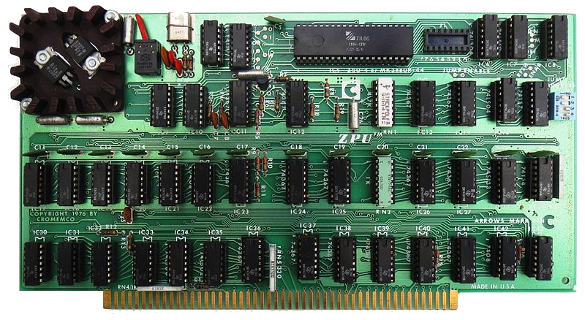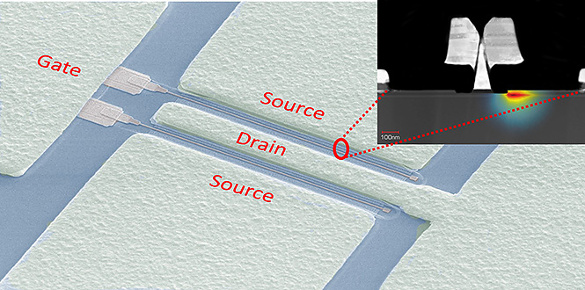Phonon Noise
December 17, 2014
I had an
early buy-in to
personal computing. A few years before the
Apple Computer and the
IBM PC, whose introduction most people identify with the start of personal computing, there was
S-100 bus hardware and
CP/M software. My
computers at
home and at the
laboratory were built from
component cards plugged into an S-100
backplane, named for the simple reason that there were 100 card edge
contacts, fifty to a side.

A Cromemco S-100 bus ZPU card, 1976. This card used a Zilog Z-80 microprocessor operating at 4 MHz. (Via Wikimedia Commons.)
Those early days were also the days of
impact printers. Eventually, I obtained a
Diablo daisy wheel printer to print
data files and
drafts of
scientific papers and
reports. Although this printer would quickly print entire files at one time, it would also print a single
character at a time in a tip-tap
rhythm reminiscent of a
typewriter. On one slow day, probably while waiting for some
experiment to finish, I had the idea to use the computer to
simulate a person's typing at a typewriter.
Having the computer send a stream of evenly-spaced characters at ten
words per minute wouldn't be a good simulation. People do not type that regularly; instead, they type in fits, sometimes faster, sometimes slower. My computer simulated typing more convincingly through use of
1/F noise (one-over-F noise). 1/F noise, which is often called "pink noise," is one type of
noise that
electronic component designers have been fighting for
decades.
The first discovered
electronic noise was
Johnson-Nyquist noise, found in experiments by
John B. Johnson in 1926, and explained by his
Bell Labs colleague,
Harry Nyquist, in back-to-back
papers in the
Physical Review.[1-2] This
voltage noise, present across any
resistor at any
temperature above
absolute zero, is given as,

where
vn is the
root-mean-square (rms) noise voltage,
kB is the
Boltzmann constant (1.3806 x 10
−23 joule/
kelvin),
R is the
resistance (
ohms),
T is the absolute temperature (kelvin), and
Δf is the
frequency interval over which the noise voltage is measured (
hertz). This noise doesn't depend on where the frequency interval is taken, so it's
frequency-independent noise, often called "
white noise." It can be called 1/F
0 noise, since taking frequency to the zero
power yields one. Most
radio frequency connections are made at fifty ohms; and, for that
source impedance, there's a
nanovolt of noise in every hertz
bandwidth at
room temperature.
One-over-F noise is different from white noise, since it increases at lower frequencies. If you look at a noise source on an
oscilloscope, you'll see the overall "fuzz" caused by white noise, but this white noise will ride atop a wandering baseline of 1/F noise. This noise was first discovered in
vacuum tubes, but it's found in all electronics, and even other
physical systems. In
semiconductor devices, it's generally caused by
defects at
material interfaces where
electrons and
holes are
randomly captured and released. It's not important at higher frequencies, and there's a "corner frequency" defined as the point where the pink and white noise components are equal.
As the above thermal noise
equation expresses, if you want lower noise, you need to go to lower temperature. That's why sensitive
amplifiers for many experiments are cooled to
cryogenic temperatures. Now, an international team of
scientists from
Chalmers University of Technology (Gothenburg, Sweden), the
Universidad de Salamanca (Salamanca, Spain), the
Low Noise Factory AB (Mölndal, Sweden), and the
California Institute of Technology (Pasadena, California) has found that there's a thermal noise at low temperatures that can't be removed. That's a noise caused by self-heating at cryogenic temperatures.[3-5]
Microwave amplifiers operating at low temperature are important in
radio astronomy, and they enabled observations of the
cosmic microwave background radiation. The amplifiers are
transistorized low-noise amplifiers, and scientists at Chalmers University of Technology and a Chalmers spin-off, the Low Noise Factory, are developing optimized
indium phosphide transistors for low noise amplification. As
Jan Grahn, a
professor of
microwave technology at Chalmers, says,
"Cooling the amplifier modules to -260 degrees Celsius enables them to operate with the highest signal-to-noise ratio possible today... These advanced cryogenic amplifiers are of tremendous significance for signal detection in many areas of science, ranging from quantum computers to radio astronomy.”[5]
When these amplifiers were cooled to just a tenth of a degree above
absolute zero (-273° Celsius), it was expected that the only noise would be that associated with so-called "
hot electrons." Instead, it was found that self-heating of the transistors was a problem, since the mechanism for
heat transfer in
solids, the
phonons, are not that effective at such low temperatures.[3-5]
At about 20 kelvin, the high
energy phonons that are most efficient at transporting heat are absent, so only low energy phonons are there to transfer heat. Says
Austin Minnich , an
assistant professor in
Caltech's Division of Engineering and Applied Science and an
author of the study, "As a result, the transistor heats up until the temperature has increased enough that high-energy phonons become available again."[4]

A scanning electron microscope image of an indium phosphide high electron mobility transistor, with an inset showing the region affected by self-heating. (Chalmers University of Technology image.)
Although this type of noise had been known for many years, its importance at very low temperatures wasn't realized. A chance meeting at Caltech between
Joel Schleeh, first author of the study and a
postdoc at Chalmers, and Minnich launched the research project. Schleeh was seeing more noise than he thought he should in such amplifiers, and conversation with Minnich connected this finding with phonons.[4]
One thing about noise, everyone wants to get rid of it, and this research has suggested some possibilities for doing this. The transistor design could be changed to allow phonons to operate in a larger
volume. Says Minnisch, "If you can make the phonon generation more spread out, then in principle you could reduce the temperature rise that occurs."[4] The research was funded by the
Swedish Governmental Agency for Innovation Systems (Vinnova), the
National Science Foundation, and a Caltech
start-up fund.[4-5]
References:
- J. B. Johnson, "Thermal Agitation of Electricity in Conductors," Phys. Rev., vol. 32 (July 1, 1928), pp. 97ff..
- H. Nyquis, "Thermal Agitation of Electric Charge in Conductors," Phys. Rev., vol. 32 (July 1, 1928), pp. 110ff..
- J. Schleeh, J. Mateos, I. Íñiguez-de-la-Torre, N. Wadefalk, P. A. Nilsson, J. Grahn, and A. J. Minnich, "Phonon black-body radiation limit for heat dissipation in electronics," Nature Materials (advance online publication, November 10, 2014), doi:10.1038/nmat4126.
- Ker Than, "Heat Transfer Sets the Noise Floor for Ultrasensitive Electronics," California Institute of Technology Press Release, November 10, 2014.
- Noise in a microwave amplifier is limited by quantum particles of heat, Chalmers University of Technology Press Release, November 10, 2014.
Permanent Link to this article
Linked Keywords: Early buy-in; personal computing; Apple II; Apple Computer; IBM Personal Computer; IBM PC; S-100 bus; computing hardware; CP/M; software; computer; home; laboratory; printed circuit board; component card; backplane; electrical connector; electrical contact; Cromemco; Zilog; Z-80; microprocessor; hertz; MHz; Wikimedia Commons; impact printer; Diablo Data Systems; daisy wheel printer; data file; draft document; scientific literature; scientific paper; report; alphabet character; rhythm; typewriter; experiment; computer simulation; simulate; words per minute; pink noise; 1/F noise; noise; electronic component; designer; decade; electronic noise; Johnson-Nyquist noise; John Bertrand Johnson; Bell Labs; colleague; Harry Nyquist; Physical Review; voltage; resistor; temperature; absolute zero; root-mean-square; Boltzmann constant; joule; kelvin; resistance; ohm; frequency; hertz; independent variable; frequency-independent; white noise; exponentiation; radio frequency; output impedance; source impedance; nanovolt; bandwidth; room temperature; oscilloscope; vacuum tube; physics; physical; system; semiconductor device; crystallographic defect; material; interface; electron; hole; randomness; random; equation; amplifier; cryogenic; scientist; Chalmers University of Technology (Gothenburg, Sweden); University of Salamanca; Universidad de Salamanca (Salamanca, Spain); Low Noise Factory AB (Mölndal, Sweden); California Institute of Technology (Pasadena, California); microwave; radio astronomy; cosmic microwave background radiation; transistor; transistorize; indium phosphide; Jan Grahn; professor; microwave technology; Celsius; signal-to-noise ratio; science; quantum computer; absolute zero; hot-carrier injection; hot electron; heat transfer; solid; phonon; energy; Austin Minnich; assistant professor; Division of Engineering and Applied Science; author; scanning electron microscope; high electron mobility transistor; Joel Schleeh; postdoctoral research; postdoc; volume; Swedish Governmental Agency for Innovation Systems (Vinnova); National Science Foundation; startup company.